


















































Capturing beautifully intimate images, such as this close-up detail of a female mute swan at rest, can be straightforward with these large and often confiding birds. Highly communicative, they will let you know immediately if you venture too close, too quickly. Invest time in their company, sit at a comfortable distance and allow them to become familiar with your presence. Only then can you inch slightly closer, but if they hiss, or puff out their feathers, retreat immediately.
PARKINSON
One of the most imposing and intimidating sights in the UK countryside is a territorial mute swan in full threat posture. Here the subject of his ire was an unwelcome Canada goose, the size of the swan’s bow wave clearly illustrating the extent of his malevolent, surging intent. By photographing from water level, I was able to capture a more intimate, goose-eye view of this behaviour, the now-distant background thrown effectively out of focus.

ANDY PARKINSON
is one of Europe’s leading photographers and a Nikon Europe Ambassador (Wildlife). His work has been published in National Geographic and many other magazines.

I’m delighted to have joined WWT at such an exciting time in the charity’s history. In early March, we welcomed HRH The Prince of Wales to Slimbridge for the inaugural meeting of the Blue Recovery Leaders Group (page 9).
The occasion beautifully summed up WWT. We celebrated the vision of our founder, Sir Peter Scott, as a pioneer of modern conservation – and showcased this pioneering spirit today through our plans for a blue recovery, demonstrating how thriving healthy wetlands can be a positive agent for change in the face of the climate, nature and wellbeing crises (see page 24).

The past two years have been challenging, yet thanks to your unerring commitment to our cause, and under the skilful stewardship of Chief Operating Officer Kevin Peberdy, WWT has weathered one of the most difficult periods in its history and come out stronger. Every membership, every visit to one of our wetland centres and every donation you make enables us to continue to speak up for wetlands, the incredible wildlife they support and their value to the nation.
With your support, WWT delivers amazing things for wetlands, wildlife and people. We offer solutions and hope for the future, with a global reach grounded in science, engagement and local action. Our vision is clear: to create a world where healthy wetlands thrive and enrich lives.
Our aims are ambitious: to create 100,000 hectares of new wetland in the UK, to have one million people taking action for wetlands and, in our global work, to be community-led and supported by key decision makers. I’m here to help turn this vision into reality, and will be shaping our future strategy to do this. We can only do this with the help of our many partners and you our supporters. It’s not always going to be easy, but it is going to be rewarding. My thanks to you for your support in what we do.




…and give back to wetlands and wildlife with every purchase. wwt.org.uk/shop
To learn more and request your free Guide to Gifts in Wills, please contact our Legacy Team via giftsinwills@ wwt.org.uk, on 01453 891150 or visit wwt.org.uk/gifts-in-wills



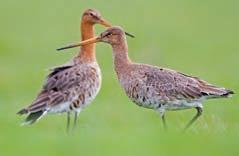



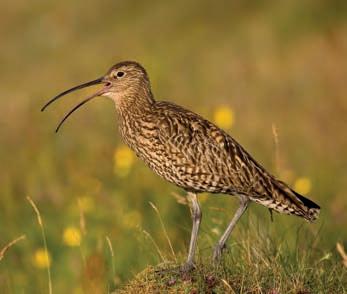
6 Welcome and Contents Our new CEO, Sarah Fowler, on the future of WWT
9 Update WWT conservation news from around the world
19 Waterlines Nature writer Amy-Jane Beer muses on the meaning of wetlands
21 Your views Your letters, plus our top shots from your photographs
22 ID guide Our new series reveals how to identify common dragonflies and damselflies
24 Urban wetlands and wellbeing How blue therapy is good for us all
32 Science in action Our new series reveals how headstarting young waders works
34 Waders under threat Waders are in trouble, but we can stop their decline if we act now
41 Photo competition It’s back! Don’t miss the return of our popular photography contest
42 Go wild Find out what it’s like to be a keeper at London Wetland Centre
45 Great days out There’s still so much to enjoy at a wetland centre near you this summer
66 Back chat Meet two of WWT’s lifetime members and find out why they support our work

WWT is the leading global conservation organisation committed to the protection of wetlands and all that live in and around them. WWT is the only UK charity with a national network of specialist wetland centres that people can visit. It was founded in 1946 by the late Sir Peter Scott, the renowned naturalist and artist.
HEADQUARTERS
Wildfowl & Wetlands Trust Slimbridge, Gloucestershire GL2 7BT wwt.org.uk membership@wwt.org.uk
Registered Charity No. 1030884 and SC039410
CENTRES
For full contact details, please see individual centre pages, from page 45
WWT Arundel 01903 883355
WWT Caerlaverock 01387 770200
WWT Castle Espie 028 9187 4146
WWT Llanelli 01554 741087
WWT London 020 8409 4400
WWT Martin Mere 01704 895181
WWT Slimbridge 01453 891900
WWT Washington 0191 416 5454
WWT Welney 01353 860711
WATERLIFE
The magazine of the Wildfowl & Wetlands Trust
Managing editor: Sophie Gore Browne waterlife@wwt.org.uk
Editor: Sophie Stafford sophie.stafford@thinkpublishing.co.uk
Chief sub-editor: Marion Thompson
Art director: George Walker
Contributors: Amy-Jane Beer, Paul Bloomfield, Jo Caird, Dominic Couzens, Derek Niemann, Andy Parkinson
Editorial board: Tomos Avent, Kate Dawson, Andrew Foot, Geoff Hilton, Peter Lee, Rob Shore, Mark Simpson
Sales executive: Jamie Dawson 020 3771 7201 jamie.dawson@thinkpublishing.co.uk
Client engagement director: Clare Harris, Think Media Group, 20 Mortimer Street, London W1T 3JW; thinkpublishing.co.uk
Waterlife is published three times a year, and is printed by Walstead Peterborough on Leipa ultraMag Plus, an FSC® certified paper containing 100% recycled content.
Views expressed in the magazine do not necessarily reflect those of WWT.
ISSN: 1752-7392

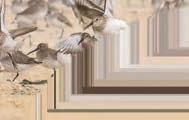
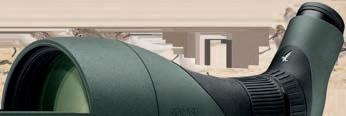










We were delighted to welcome His Royal Highness The Prince of Wales to join the inaugural Blue Recovery Leaders Group meeting at WWT Slimbridge in March. The meeting, led by Natural England Chair Tony Juniper, brought together representatives from a range of leading organisations across housing, water, charity, engineering, banking and other sectors, all of whom pledged to help WWT reach its Blue Recovery goal of creating 100,000 hectares of new and restored wetlands across the country.
Members of the group – who have an interest in creating wetlands to help meet the objectives of their own organisations, and in working together to identify, develop and deliver projects – signed a
‘statement of intent’ that commits them to exploring ways to work together to help achieve this aim. Member organisations include National Grid, Severn Trent Water, Triodos Bank, Berkeley Group, Jacobs and Eversheds and People’s Postcode Lottery.
“We were delighted that His Royal Highness was able to join us for the first meeting of our Blue Recovery Leaders Group,” said Dr James Robinson, WWT’s Director of Conservation. “I know he cares passionately about nature and his interest in our work helps showcase how important wetlands are.”
During his visit, the prince – who became our patron five years ago –also officially opened Scott House Museum, former home of WWT founder Sir Peter Scott.


Summer is here and I am spending more time outdoors in my local wetlands. These urban blue spaces help me escape daily pressures and I am not alone – the marshes host walkers and runners, the reservoirs welcome a wide range of visitors, the brook draws local families and the rain gardens attract people en route to work or local shops.
These wetlands are gym buddies and stress busters, and evidence shows that spending time in blue spaces can be even better for you than green spaces. WWT’s research has found that spending just 10 minutes in an urban wetland can improve your mood. I see this all the time when neighbours admire the flowers colonising concrete spaces, share reports of exotic migrants or watch the rain gardens soak up surface water.
Thesewetlandsareanessentialpartofour community’sresilienceandwearefortunateto havethem.Butaccesstonaturalspacesisvery unequal–currently,oneinthreepeopledon’t haveaccesstonaturewithina15-minutewalk. Andwithpoormentalhealthaccountingfor40% ofGPappointments,affectingoneinfourpeople
eachyearandcostingtheNHSover£34bnayear, theGovernmentcannotaffordtoignorethis.
This is why WWT is calling on policymakers to recognise the role wetlands can play in addressing health inequalities, and incorporate them into broader ambitions to ‘level up’ and spread opportunity more equally across the country. Access to nature should be adopted as a core test of this, with a commitment made to measure access to – and use of – wetlands, a legal requirement for developers and public bodies to provide wetlands for everyone, and funding to create more of these precious blue spaces. This would help create urban wetlands across the country, so everyone has access to these vital places and the many benefits they provide.
These wetlands are an essential part of our community’s resilience and we are fortunate to have them
DO ONE THING
Nature for everyone everywhere – sounds good, right? Please help us to put a right to nature into law by supporting the Nature for Everyone campaign, in which WWT is a partner. To find out more and sign the petition, visit wcl.org.uk/nature-foreveryone-launch.asp
Tom Fewins heads up WWT’s Policy and Advocacy team, and works with Government, political parties, business and wider society to build support for wetlands.


We’re excited to welcome Ollie Olanipekun and Nadeem Perera of Flock Together as WWT’s first ambassadors – a new role encouraging support and engagement from public figures to help raise awareness of the importance of wetlands.
“Flock Together is a birdwatching collective that recognises nature is a universal resource, and is dedicated to ensuring people of colour feel welcome in it,” says Wildlife Director Nadeem. “We are delighted to be working with WWT because it shares our philosophy and is keen to make wetlands accessible to all through initiatives such as its Generation Wild programme.”
In addition, writer and broadcaster Kate Humble has been reappointed as WWT President for a further three years, alongside four Vice Presidents: broadcaster, writer and wildlife photographer Mark Carwardine;
ecologist, ornithologist and broadcaster Mike Dilger; David Lindo (aka the Urban Birder); and Chris Packham CBE.
“WWT’s proactive, hands-on and can-do approach to conservation has always appealed to me, and I feel very at home with the way the charity engages with the public,” says Kate, who has been WWT President since 2018. “WWT is determined that wildlife is for everybody to enjoy, and that’s very much my perspective too.”
“We are delighted to be working with WWT because the charity is keen to make wetlands accessible to all”
“Finding natural solutions to the climate crisis has never been so important,” adds Chris. “That’s one of the reasons why I support WWT and its mission to create vital new wetlands in the UK.”
Also continuing as Vice Presidents are Georgina Fitzalan-Howard, Duchess of Norfolk and Dr Dafila Scott, daughter of WWT founder Sir Peter Scott.
“I’m delighted that one of my first duties is to welcome our new ambassadors and thank our existing high-profile supporters for their continued commitment,” adds Chief Executive Sarah Fowler, who joined WWT in March. “We have lots planned for the next three years, and I am delighted that they are on board for the next stage of WWT’s journey – putting wetlands centre stage in the fight against climate change and the loss of nature as well as other global issues.”

The giant barb, or carp, is the national fish of Cambodia. It frequents deep pools along river edges

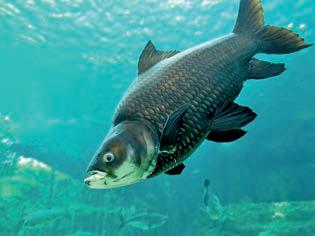
The presence of a huge, critically endangered fish – the giant carp – was one of the key findings from a pioneering species survey at an important Cambodian wetland. For over 10 years, WWT has collaborated with communities and local and national government agencies to protect and restore wetlands at Boeung Prek Lapouv Protected Landscape in Cambodia’s far south.
We’ve worked with farmers and fishers here to develop projects encouraging sustainable resource management and community-based conservation. Though the region’s birdlife is well studied, there was little information on fish... until now.
In 2021, with support from Keidanren Nature Conservation Fund, a local expert conducted an assessment of fish species at eight locations across the 8,500-hectare wetland, covering a variety of habitats including areas converted for rice farming, and using five methods including traditional capture and eDNA sampling.
Forty-two species of fish were recorded, including five of global conservation concern – notably one giant carp. Cambodia’s extraordinary national fish grows to 3m long, but its abundance has plummeted over the past 20 years or so. Confirmation of the presence of this critically endangered species is crucial, as it strengthens the case for protecting flooded forest – a much-needed nursery habitat for fish in the area, as only 1.3% of the protected landscape is forested.
Last year, WWT planted five hectares of flooded forest in the wetland’s northern section, and we plan to do a lot more in the coming years. The fish survey provides a baseline snapshot of species at the wetland. This can be used to steer site management decisions based on those species’ ecological needs, and to measure future surveys against to identify changes in fish populations.
It often seems that wildlife hasn’t ‘read the rule book’, so we shouldn’t have been surprised when kingfishers decided that the newly improved artificial sand martin bank at WWT Arundel was the perfect place to nest this spring.
Over the winter, we’ve improved the Peter Scott Lagoon and adjacent habitat, thanks to funding from the Countryside Stewardship Scheme. The islands that had eroded away over time have been re-established and reinforced with special edging, and a new island has been created in front of the hide. This will improve nesting opportunities for waders and encourage the return of common terns, which have been absent from the site as a breeding species for six years.
We’ve also created underwater causeways between the islands – paths that are just below the water surface to allow access for people – to make future management more efficient and cause less disturbance.
Adding pebbles between the water’s edge and the artificial sand martin bank has improved the visual connectivity of the bank to the water, and in between we have maintained a strip of wildflowers, providing nourishing invertebrates for all those chicks! Juvenile warblers really enjoy this area in the summer.
As Waterlife goes to press, the sand martins are returning and will hopefully nest in greater numbers this year. But the kingfishers have already given it their stamp of approval.
90% £20,000 6,000+
of the UK’s wetlands have been lost over the past 1,000 years
the amazing amount you raised for curlews during The Big Give week in April. Thank you!
the number of pledges our Wetlands Can! campaign has received. Add your voice today!
 Chris Penrice
Chris Penrice

Your support of WWT not only enables us to create, restore and conserve vital wetland landscapes in the UK – it also helps engage people and conserve hundreds of other wetlands worldwide.
Since 1991, we’ve run Wetland Link International (WLI), a network of 350 wetland centres, backed by a small team of WWT-funded staff at Slimbridge. The WLI network brings together these wetland centres from around the globe to share expertise and resources to deliver better wetland conservation, management, education and engagement.
And it’s all thanks to your membership that we can provide this support network and enable better protection and conservation of the world’s most special wetlands and wetland species. Here are just some of them...


Pointe-à-Pierre Wildfowl Trust, Trinidad and Tobago, is the site of a successful reintroduction programme, following local extirpation of the species earlier last century.

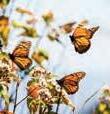
The Wetlands Institute, US, is conducting a long-term tag and survey research project to better understand the journeys of this migratory insect, which stops in New Jersey en route from Mexico each autumn.








We’ve launched a quartet of ambitious new projects, thanks to generous awards of funding from government and corporate donors

We can’t promise you a barn owl, but there’ll be lots to photograph
WWT has partnered with Nikon to provide photography experience days at Slimbridge for people with reduced mobility. Experts from the Nikon School will be providing tips on camera settings and techniques, with opportunities to photograph a myriad of wildfowl using the many accessible hides at the centre. A fleet of mobility scooters will be available for participants to use throughout the day. For details of the next event, visit nikonschool. co.uk/courses/wildlife
A new Code of Practice, designed by Berkeley Group in partnership with WWT and Blue Green Studio, will ensure that property developments built by Berkeley Group will incorporate blue and green spaces. The code, launched with an event at our London Wetland Centre in March, helps Berkeley staff understand why sustainable water management can radically change how developments look and feel, and how they support nature too. Benefits from this approach include improving air quality, reducing the risk of flooding, supporting biodiversity, and providing health and wellbeing benefits for the local community.

We’re delighted to be working with Deloitte in a new partnership supporting our aim of creating and restoring 100,000 hectares of wetlands in the UK. Selecting WWT as one of three new WorldClimate charity partners, Deloitte will provide its services pro bono to help us promote the value of wetland creation to companies tackling climate change. Together, we will focus on the role of saltmarsh in capturing and locking away blue carbon, making funding for saltmarsh more sustainable and accessible. And we’ll enable Deloitte employees and clients to take action for wetlands by joining conservation volunteering days at our sites.
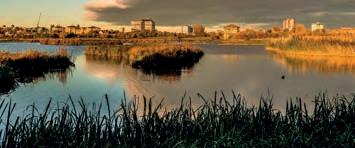

Our Flourishing Floodplains project, restoring wetland habitats in the Severn and Avon Vales, is making good progress. Across the Severn Vale’s floodplain meadows, some 60% of ponds – supporting diverse freshwater species and important for declining farmland birds – have been lost over the past century. This spring, working with partners, local landowners and communities, we started creating and restoring ponds across a 4,000-hectare landscape, as well as surveying curlew nest territories and grasslands, assessing stored carbon in soil and sampling environmental DNA to assess abundance of critically endangered European eels. The project is funded by the Government’s Green Recovery Challenge Fund. wwt.org.uk/flourishing-floodplains




It occurred to me the other day (belatedly, given that I had already agreed to write this column), that I didn’t know the exact definition of a wetland. We were walking in the Yorkshire Dales, under a soft skylark rain, ecstatic squalls of curlew song and the squeaky dog-toy weeps of lapwing.
Rushes brushed my trouser legs, water squelched with every step. Wet land, for sure. But wetland? I couldn’t say. It’s April at the time of writing, and by the time you read this the waders will be gone and that same land may well be cracking dry.
There are scientific definitions, of course –specifying permanent or seasonal inundation or saturation; characteristic vegetation types. Someone will have done a survey, ticked a box, made a designation. But even that could change with climate, with upstream management, with the arrival or extinction of species. There’s nothing static about wet, or land. Like much of nature, neither care for categories.
What I do know is that these places exert extraordinary power over us. We might articulate a million reasons for our attraction to them: an interest in birds or insects; the wellbeing benefits of wild swimming or paddleboarding; the solitude of a day’s fishing. Perhaps they are just the easiest way to please a whole family on a day out. But there’s more to it than that, I’m sure.
We are water born and waterborne: brinyblooded, our cells are swamps that fizz and bubble with uncountable reactions that can only

Water behaves like no other molecule: shape-shifter, mover of mountains, bearer of fertility, soother of souls, springer of surprises, giver and taker of life, universal solvent and agent of endless change
happen with this chemical loose cannon as a medium. Water behaves like no other molecule: shape-shifter, mover of mountains, bearer of fertility, soother of souls, springer of surprises, giver and taker of life, universal solvent and agent of endless change. We can’t get enough of this weird, wild, wet stuff because it is the ancient home we carry inside us still.
Wetlands are as ineffable as water. Never wholly one thing, they are edge-scapes, ecotones, liminal spaces: always dynamic, always dual. It is this inconsistency, this fluidity, this queerness, even, that makes them so biologically diverse. Perhaps that’s what draws us too. In places that are neither one thing or another but an endlessly shifting all-ness, there is – or should be – space for every wild life, human or more than.
DO ONE THING
Locate your nearest wetland or river and get to know it if you can. It may be privately owned, but you are at liberty to care and to ask questions about its status.
Amy’s book The Flow: rivers, water and wildness will be published on 4 August.

We love to hear your thoughts about wetlands, WWT and Waterlife, and share your photos, so please email them to us at waterlife@wwt.org.uk or write to the address on page 7
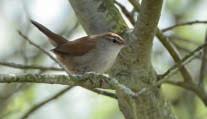
InspiredbyWinterwatch,I discoveredWWTWelneyisnear enoughforadaytrip.Ihadalovely timeexploring.Theswanfeeds wereinterestingandIsawabrown hareonashortwalkonLadyFen. Thedaywascompletedbyabarn owlandtwoshort-earedowls. Iwilldefinitelybemakingarepeat visitlaterintheyear.
Janet Avery, Colchester, EssexInApril,Ienjoyedthe incrediblesightofaCetti’s warbleratLondonWetland Centre.Ibroughtittothe attentionofoneofthe wardens,whosaidthat,in 20years,he’dneverseen morethanafleetingdash ofone.Itmademyvisit.
Terence Baker, London

JustwantedtoletyouknowIparticularly enjoyedtheMarch/June2022issue. Ihavebeenamemberforages,maybe 10years,butthisissueofWaterlifewith theduckidentificationguideandthe photographymasterclasswasoneof thebestIreckon.Nicejob.
Andrew Foreman
WWT says: Thanks Andrew!

“I found my first visit to WWT Llanelli most enjoyable. I can’t wait to go again. I thought you may like a photo of two white-headed ducks having a disagreement.” Ken Weldon, via email

InMarch,wewatched twogreatcrestedgrebesat LondonWetlandCentre. Thegrebesweredisplaying, shakingtheirheads,then theybothdivedatthesame time.Iknewwhatwould happennextandquickly gotmycamerajustintime tocatchthisweeddisplay.
Les McCallum,Isleworth
“I took this picture on a recent visit to Martin Mere. I am quite pleased with the detail in the swan’s bill and feathering on the head.”
Colin Perry, via email

Namecheck:ThankyoutoIanFosterforhighlightingtheproposedchangeofsomebird namesfromAnastoSpatula.WWTisreviewingitstaxonomicalnamingconventions.
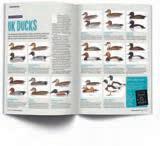
Ken wins a copy of Where to Watch Birds in Britain by Simon Harrap and Nigel Redman, worth £25 and available in our shops and online.


We love to see your photographs taken at our centres. Please send your best shots to Waterlife and they could be published in a future issue. Just email your high-res images and a short story about what you photographed to waterlife@wwt.org.uk We can’t wait to see what you can do!

These beautiful, graceful insects are a highlight of any visit to a WWT centre. Designed perfectly for their aerial lifestyle, they are acrobatic and fascinating to watch

Pyrrhosoma nymphula
This medium-sized damselfly is the earliest to emerge in the UK, being on the wing from late April to August. Males are red with a black thorax; females may be almost all black.


Calopteryx splendens

Ischnura elegans
This is a small, dark damselfly – the male is mostly black. It is common in the UK and is easily seen on almost any waterbody from April to September, even garden ponds.


Calopteryx virgo

Enallagma cyathigerum
Our most common damselfly can be found around almost any waterbody, where it frequents open water. On the wing from April to September, it regularly visits gardens.

Coenagrion puella
This small, pale-blue damselfly is on the wing from late May to September. It is common around small ponds and streams, and at the edges of larger waterbodies.

Lestes sponsa
A large damselfly that favours slow-flowing waterbodies with lush vegetation. Males are metallic blue, with a dark band across their wings that gives the species its name.
This giant among damselflies is hard to miss with its metallic-blue and green colours. Look for its fluttering, butterfly-like wings over small, fast-flowing rivers in the west of the UK.
Unlike other species, this stunning metallicgreen damselfly holds its wings half-open when perched. It can be seen on vegetation at the water’s edges June to September. Illustrations

BROWN HAWKER
Aeshna grandis
A large, brown dragonfly with distinctive golden-brown wings. It has significantly increased its range across Britain in recent years. Hunts well away from water.
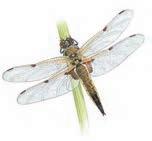
FOUR-SPOT CHASER
Libellula quadrimaculata
Easily recognised by the two dark spots on the leading edge of each wing that give this species its name. It is active from May to September, sometimes October.
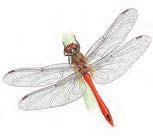
RUDDY DARTER
Sympetrum sanguineum
One of the most common darter species, especially on well-vegetated waterbodies in June to September. Abdomen is blood-red and club-shaped. Distribution is expanding.

SOUTHERN HAWKER
Aeshna cyanea
This common dragonfly of ponds, lakes and canals near woodland is on the wing from late June to October. A fast-flying species, it can be seen patrolling the water.

BROAD-BODIED CHASER
Libellula depressa
A common dragonfly with a flattened body that gives it a fat, broad look. Seen in summer, from May to August, around ponds and lakes, and even in gardens.

COMMON DARTER
Sympetrum striolatum
This common red, narrow-bodied dragonfly is on the wing in summer and autumn. It breeds in all kinds of waterbodies, where it hovers then darts forward to catch insects.

EMPEROR DRAGONFLY
Anax imperator
An impressively large and colourful dragonfly of ponds, lakes, canals and flooded gravel pits. It flies between June and August and even eats its prey on the wing.

BLACK-TAILED SKIMMER
Orthetrum cancellatum
A narrow-bodied dragonfly on the wing from May to August. Often seen flying low over the water of flooded gravel pits and reservoirs before landing on the bare shore.
These beautiful illustrations are taken from the Collins Pocket Guide to Freshwater Life: Britain and Northern Europe, the ideal freshwater companion and ID guide published by Collins (RRP £20). Available to buy online and from all good bookshops.


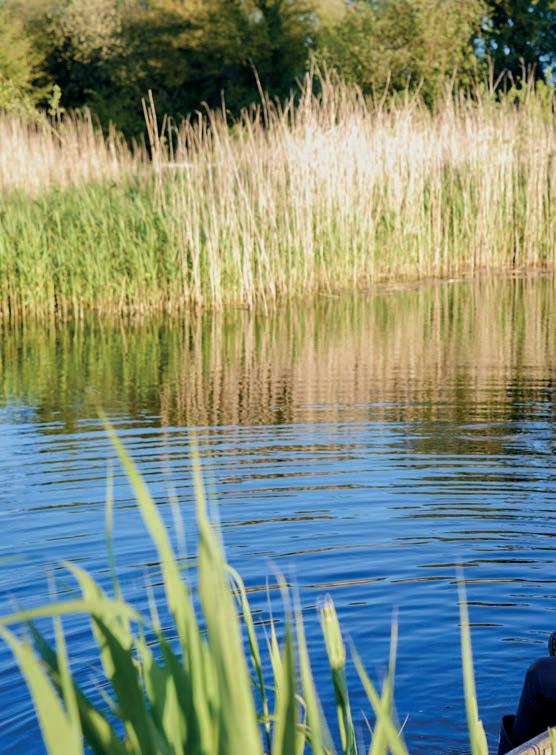
Wetlands are not just beautiful – there is increasing evidence that they’re good for us too. Now WWT is harnessing the power of nature to improve the way we feel
BY DEREK NIEMANN

Millions of people felt their spirits lifted by nature during the first summer of the pandemic. It became an antidote to lockdown, our hearts raised by the sight of a swallow, a walk by the river. Few people understood its restorative powers quite as much as Joe Harkness.
Long before Covid, Joe had been in the darkest of places, so beaten down with mental health problems that he considered taking his own life: “There was a period of time when I’d lost an entire friendship group and I didn’t know what to do. I thought I could just go out walking. The first couple of times I went out and looked at birds. Until then I hadn’t been remotely interested in wildlife. But it didn’t take long for me to realise that something good was happening. I thought – this is giving me some focus, this is making me feel happy. I began to find purpose, hope, direction, solace, comfort.”
Almost miraculously, Joe had stumbled into an effective way of treating himself. He was unwittingly following the ‘five ways to wellbeing’, recommended by mental health charity Mind, through nature (see box on the right). Once enlightened, he dubbed them his ‘five ways to wellbirding’. He looks back at that dark time convinced that wetlands, in particular, were his salvation.
“There’s an extra dimension. I just know that in places with water I’m going
to see more. When I go out to a lake, I know I’m going to see mute swans, moorhens and little grebes. But I also have the absolute reassurance that I will see a different bird to the ones I normally see. Anything else is an added bonus. It brings hope.
“Then add the different seasons and what might drop in. Waders on migration, whatever might turn up if the wet meadow floods. And it isn’t just birds. There’s a whole plethora of other things to look at, and in wetlands I see more plants and insects. Water is a sustaining part of our


environment for everyone and everything. I’m certain that going to these places will bring new experiences and that can only lift my mood.”
Joe’s own recovery came at a time when professionals were rethinking their approaches to treating patients with mental health issues. A new way of thinking, that considered the personal needs and inclinations of the individual, came into being under the banner of ‘social prescribing’. The NHS describes it as “helping patients to improve their health, wellbeing and social welfare by connecting them to community services, which might be run by the council or a local charity”. It was a natural step for this to include nature. Green prescribing began. And blue prescribing too? Could wholehearted acceptance of wetlands as places to benefit human mental health provide yet another
“We went on a nature walk, which is really great to clear your mind and feel at peace with yourself”
Research shows that people experiencing stress can use green and blue spaces to improve wellbeing through walking and exercise
 Andy Parkinson
Andy Parkinson

1 CONNECT
We can connect to nature and connect to other people through nature. Talk to others about what you have found and share the delights of discovery. Even the briefest of chats on a wild walk helps to build social relationships, a fundamental human need.
2 BE ACTIVE
Regular physical activity is associated with lower rates of depression and anxiety across all age groups. Your visit to a wild place is exercising your mind as well as your body, and it doesn’t need to be strenuous to work.
3 TAKE NOTICE
Studies show that having awareness of what is around us and living ‘in the moment’ enhances our wellbeing. Can you feel satisfaction in spotting a dragonfly on its perch, or even a kingfisher concealed in the bushes?
4 LEARN
Sustaining our desire to learn enhances our selfesteem, and encourages social interaction and a more active life. Take pleasure in discovering new things on your visit to a wetland. You might watch and then read up on how a swan preens, or how a cormorant catches fish. Setting ourselves achievable goals is strongly linked to higher levels of wellbeing.
5 GIVE
People with a greater interest in helping others are more likely to believe themselves happy. And maybe the same applies to helping nature. Could you benefit wildlife and help others to enjoy wildlife more?





We’re working with over 60 organisations on the Nature for Everyone campaign, calling for new Levelling Up laws to require public bodies and developers to provide access to naturerich local spaces for everyone. This would lead to urban wetland creation where it’s most needed. There are four types of urban wetlands we need more of:
● New or restored urban parks centred on lakes, rivers and ponds that create new spaces for recreation, relaxation and travel.
● Restored streams and wildlife ponds that reconnect networks of wetlands, integrating restorative blue spaces into communities.
● Natural sustainable drainage systems (SuDS) such as rain gardens, swales and small ponds, which provide wellbeing benefits where people live and work.
● Mini wetlands in people’s homes, such as garden ponds and drainpipe wetlands.
To find out more and sign the campaign petition, search online for ‘Nature for everyone’.

Take
reasonforcreating,improvingand valuingthem?
Aboutthreeyearsago,WWTdippeditstoe intothewellbeingwater,settingupapilot schemeatSlimbridgeforasmallnumber oflocalpeopleaffectedbymentalhealth issues.Theresultswereencouraging,the projectexpanded.FirstSteartMarshesin Somersetandthen,earlierthisyear,blue prescribingarrivedintheUKcapital.
RakshaPatel-CalverleyjoinedWWT asHealthandWellbeingOfficerina partnershipprojectwiththeMentalHealth FoundationatLondonWetlandCentre: “EverymorningItakemyselfoutfora walkalongtheThamesbeforeworkto remindmyselfofwhyI’mthere.It’sreally importanttogetintothemindsetofbeing aroundbluespaces,howtheycanimpact onus,howtheycangroundusonadaily basis.Youcanbewalkingandworrying aboutthings,butwhenyoustoptowatch thebirds,youarecompletelyabsorbed inthatmoment.”
“People come on this course so that they develop tools they can use in their daily life”
Thewetlandcentrewelcomeditsfirst participantsfromallacrossLondonforthe six-weekcoursewithRakshaandProject ManagerAbimbolaJunaidinthespring. “Beforehand,peoplewereanxiousand nervous.They’dnevermetusoreachother beforeanddidn’tknowwhattoexpect. Theywantedtotaketheirtime,walkat theirownpaceandabsorbeverything.They justwantedtoslowrightdownbecauselife hadbeentoobusy.”
Veryquickly,Rakshabegantonotice improvementsinmoodandconfidence. Shehadpreparedcoursematerialsand activitiessuchasbarkrubbing,treehugging andbirdwatchingusingbinoculars,many ofwhichtheparticipantshadnevertried before.Ordinaryvisitorsinthehidesfreely offeredadviceandkindness.



“Someoftheparticipantsstartedtofeel morecomfortableopeningupaboutthe reallyhardtimestheyhadbeenthrough. Sometimesthetendernesstheyshowedeach otherleftmelostforwords.Oneladywrote tousaboutfeelinganxiousanddepressed partwaythrough,saying‘Istillwenttothe courseandIwasabletotalkopenlywith themandtheyhelpedmeputintoorder howIhandledthings...Thenwewenton anaturewalk,whichisreallygreattoclear yourmindandfeelatpeacewithyourself.’”
Theparticipantsbegantogrowin themselves.“Thecourseisreallyaboutthe individualandit’sself-managed.Never mindifIhavethreeactivitiesplanned,it’s aboutaskingthegroupwhattheywantto do.Peoplecomeonthiscoursesothatthey developtoolstheycanuseintheirdailylife afteritisfinished.Wedon’twantthemtobe dependentonus,we’resupportingthemto maketheirowndecisions.”
Wheredoesblueprescribinggonext?The bigpicturecomesfromJonathanReeves,
Being in nature for at least 120 minutes a week is enough to boost physical and mental health and wellbeing

PrincipalResearchOfficerforHealthand Wellbeing:“Thenextstepistoprovide robustandconvincingdatatoshowthe medicalestablishmentthatprogrammes likeblueprescribingwork.ThisyearWWT willbeworkingwiththeUniversityof Exetertocarryoutclinicaltrialstomeasure theeffectivenessofnatureprescribing,and ourownsiteswillplayapart.”
Jonathansaysweareatathreshold:“Both theGovernmentandtheNHSareleaning onthecharitysectorandcommunity groupsasproviders,butit’sstillunclearhow wewillworkwiththeNHSintermsof deliveringprogrammes.Inourfield,social prescribingdependsontheavailability andcapacityofnaturecharitiesinanarea, whattheirappetiteisforleadingit,where theygetthefunding.Whatworksforus mightnotworkforanotherorganisation andtherewillbewidevariationinthe abilityofdifferentorganisationstocarry outanatureprescription.
“Thereisn’tonemodelthatfitsall, evenwithinWWT.WhileSlimbridge andLondonofferwell-establishedvisitor
infrastructureandbirdsupclose,Steart hasbasicfacilitiesandislessbird-focused. Sothereneedstobecloseworking betweenus,thecommunitygroupsand thehealthsector.
“Thepan-Londoninitiativemeetsour objectivesforincreasingequalityofaccess towetlandsandbluespaceandallthesocial benefitsthatcomefromthat.Wealsoneed tocreateandrestorewetlandsinurban areaswherenonecurrentlyexist,togive peopleaccesstothewellbeingbenefits”.
Nevertheless,ourfirsteffortsare beginningtobearunexpectedfruit:“At Steartwe’vefoundthatifwestartwithan intensiveandstructuredcourse,participants starttobecomeinvestedinthesite,their
coursepeergroup,andconservation.And thentheystartexpressinginterestindoing theirownthing,leadingandgalvanising theirowngroups.Theymaybeexploring otherwetlandswheretheycomefromand creatingtheirownpeerandsupportgroups. It’searlydaysbutwehopethatwecanuse blueprescribingtoseedpeopleintothe communitytogoonanddotheirownthing intheirlocalenvironment.Theadvocates thatspinoffourprogrammesmaybe energisinglocalcommunitiestocreatemore wetlands,improvethemandmanagethem.”
Wellbeingforhumans,wellbeingfor wetlands.Ifwecanputthemtogether,the prospectistrulyexciting. n

READ MORE
Bird Therapy by Joe Harkness is available from our online shop at wwt.org.uk/ bird-therapy and all good bookshops.



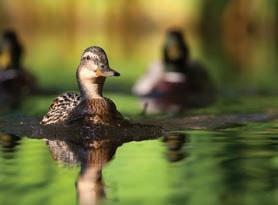









To help some of our most endangered wetland birds circumnavigate the most vulnerable part of their lives, we’ve adopted headstarting, a technique yielding impressive results
Headstarting involves captiverearing the early stages of threatened bird species, away from the raw dangers of the wild, then releasing them when they have grown up enough to be less vulnerable to predation or misfortune. It is effectively taking eggs or young and giving them a bye into a later round of life.
WWT is involved in three projects that headstart waders: spoon-billed sandpipers in the Siberian Far East and, closer to home, black-tailed godwits and curlews in the UK. All these species were declining (see page 37), and in each case the critical phase from egg to fledged young is a major crunch point, where high losses occur.
Dr Lynda Donaldson is WWT’s Principal Research Officer for Project Godwit, in partnership with RSPB. She is monitoring the black-tailed godwits on the Ouse Washes. The first task is to check which birds have returned, then see who is paired with who, before locating the nests. “This can take hours of patient observation,” she tells me. “We use a telescope to watch the birds’ comings and goings, but they’re so secretive. Sometimes all we see is a head popping up fleetingly.”
The hours of fieldwork observation at the Nene Washes enable RSPB field staff to pick the best time to collect the complete clutches of the eggs, under licence from Natural England, which will then go into the headstarting programme. Flooding during the breeding season has been a major problem for godwit clutches, so you might say that the young birds are brought to their very own ark!
“A positive of headstarting is that we often manage to collect the eggs in time for the adults to begin a replacement clutch,” says Lynda. The replacement clutches are not usually collected, so in a way, all the captive birds are a bonus. The eggs are collected by our aviculturalists who hatch them and care for the chicks until they are 27-33 days old. During this time the youngsters are placed



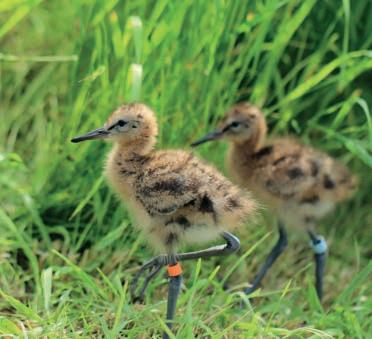

“The most exciting part is when the headstarted individuals return to the UK, and start breeding here. We’re already seeing results”
in an outdoor aviary at Welney until they can fly strongly, at which point they will be released.
“It’s vital that the birds have time to become familiar with the area,” says Lynda. “Black-tailed godwits are typically faithful to the place where they are born. The aim of this programme is that headstarted birds return to breed here in the future, to build up the local population.”
The hard work doesn’t stop with the release of the youngsters. Monitoring is vital to ensure that all the effort and money is producing results. Every headstarted youngster is fitted with colour rings in a unique combination, so they can be spotted
wherever they are wintering (usually Iberia or West Africa) and upon their return.
“The most exciting part is when the headstarted individuals return to the UK and start breeding here,” enthuses Lynda. “We’re already seeing results.” So far, since 2017, 155 black-tailed godwits have been released by Project Godwit in the Fens (in two areas, Ouse Washes and Nene Washes), of which 48 have returned after a year or more (up to 2021). Last year, 23 pairs of breeding Fens godwits were made up of at least one headstarted bird, including eight pairs that were complete headstarted matches.
“We’re really pleased that, during the project, the overall Fens godwit population
The spoon-billed sandpiper is on the brink of extinction, but headstarting has increased the number of surviving fledglings each year by 20%. More than 200 birds have been released into the wild.


Black-tailed godwits need good-quality wet grassland for nesting and to rear their chicks
has grown from 38 pairs in 2017 to 54 in 2021. And the Ouse Washes population has risen from three pairs to 19,” says Lynda. “We’ll see what 2022 brings, but the preliminary results are encouraging.”
She does, though, interject a word of caution. “Headstarting can help small, isolated populations recover, but is not a silver bullet for nationwide recovery. We have to ensure it is done hand in hand with habitat restoration and management, as WWT does here. And we need to keep studying wild populations to make sure that our conservation interventions are working.” n
Project Godwit receives major funding from the EU LIFE Nature Programme, the HSBC 150th Anniversary Fund, Natural England and the National Lottery Heritage Fund.
25%
Britain holds 25% of the world population of the Eurasian curlew. But the number of breeding birds has dropped by 65%, mainly because very few chicks survive to adulthood.
This technique involves collecting eggs, rearing chicks in captivity and releasing just after fledging. It is being used to increase and maintain the Ouse Washes populations.
1 ASSESS: Is it worth doing?
Prior to intervention, the declining species are counted and monitored to assess the population and to study the causes behind any decline. Headstarting is a useful tool to boost small populations, alongside other measures such as predator control.

3 GATHER THE CLUTCH: Bring the eggs into care. Ideally, shortly after the parents have completed their clutch, the four eggs are gathered and placed in incubators. The adults assume they have lost a clutch – a routine happening in the wild – and will often re-lay.

5 RELEASE: Time to take their chances. After a quick veterinary check, the headstarted birds are discharged into the wild. This often involves simply removing one side of the pen, allowing the birds to find their way out. Occasionally, though, they have to be encouraged to leave!


2 SURVEY: Monitor the population and find the nests. Each season, the arriving birds are counted and watched as they form pairs. Many hours of fieldwork follow as their nests are located. A parent may show guarding behaviour, there may be an incubation changeover, or a predator might flush a sitting bird.
4 HUSBANDRY: Looking after the precious youngsters. The eggs hatch in an incubator but remain in brooders for the first few days of life (five days for godwits). They are ringed with a unique colour code after they are transferred to outdoor aviaries, where they are given food. Before they can fly strongly, they are maintained in aviaries at or close to the release location.
6 PROGRESS: Are the birds behaving normally?


It’s important to check that the headstarting hasn’t altered their behaviour or reduced their rates of survival. We need to make sure they are migrating to the right places, returning when expected and, ideally, breeding. And are they surviving as well as wild-reared birds?

In north-west Europe, numbers of the Eurasian curlew have decreased sharply, making it one of the UK’s most rapidly declining breeding bird species
 Andy Parkinson/Minden Pictures
Andy Parkinson/Minden Pictures
Our wading birds are in serious decline, with species from snipe to redshank disappearing from many of their breeding grounds. So we’re working on a bold project to stem this tide and restore curlew populations in the Severn and Avon Vales and on Dartmoor
WORDS BY JO CAIRD
There are few sounds more evocative of the British countryside than the calls of our breeding waders. The plaintive lilt of a curlew. The low wobble of a snipe. The almost electronic squeak of a lapwing. Yet what was once a common occurrence is becoming an increasingly rare treat.
British wading birds are in trouble, their populations in decline. Species including snipe, redshank and lapwing have all seen the number of breeding pairs fall steeply in recent years, but it’s curlew that’s the most worrying.
“Curlews are quite long-lived birds, so even if there is no breeding success for quite a while, the population only declines fairly slowly,” explains Eric Heath, WWT’s Senior Project Manager for Species
“A 48% decline, to just 58,500 breeding pairs, over the past 25 years means that something is going drastically wrong”
Recovery. “The fact that we’ve seen a 48% decline, to just 58,500 breeding pairs, over the past 25 years means that something is going drastically wrong.”
Fortunately, we have a pretty good idea of what’s causing this decline – and not just for curlews but in other breeding waders too. “In general, they’re all affected by the same pressures,” says Dr Geoff Hilton, our Head of Conservation Evidence. Predation is a big issue for ground-nesting birds, with eggs and chicks vulnerable to mammals and birds including foxes, crows and gulls. “It is natural and normal for quite a high proportion of the eggs and chicks to fall victim to predators,” Geoff explains. “But at the moment the balance has tipped too far in favour of the predators.”
Habitat loss is another major factor, with intensive agricultural practices taking their toll on these wetland species, which favour wide, open landscapes with plentiful invertebrate food for their breeding grounds. Drainage and pesticides rid the soil of the rich invertebrate life that waders rely on,

while early mowing of grassland for silage destroys nests before chicks have fledged.
These challenges on many different fronts may seem like they are overwhelming but they are not insurmountable. By taking action now, we are restoring and recovering populations of curlews and other wading birds before it’s too late. “We’re exploring what actions we can take to turn things around,” says Eric. “First, we need to work out what’s happening to curlew nests.” To answer that question, WWT scientists have turned their focus to the Severn and Avon Vales, whose expansive floodplain meadows are home to around 35 pairs of curlews.
“We need to find curlew nests early and monitor them throughout the season,” says
Eric. This is not an easy task, even with experienced ornithologists using cuttingedge thermal drones.
“Curlews that are sitting on nests don’t flush easily, so you can be practically standing on a nest and they still will not move and give away its location,” Eric goes on ruefully. “The early part of the season is
By taking action now, we can restore and recover populations of curlews and other wading birds before it’s too late

crucial: once the grass is over a foot or so tall it becomes incredibly difficult to find a nest.”
When ornithologists do find a nest, once the eggs are hatched, the chicks will have leg rings attached so they can be identified again in the future. A small number of chicks are also fitted with radio tags. This year, a further five adults have been fitted with satellite tags. The 24/7 tracking technology will enable scientists to gain even greater insights into their behaviour over the course of the project, which runs through to the 2026 breeding season. Meanwhile, we’re trying to mitigate the threat of predators by erecting fencing around nests.
WWT is also working with farmers to develop more curlew-friendly agricultural


1. Curlew | Declined 48% to 58,500 pairs since 1995. Its habitat is lowland floodplain meadows (it’s here that the decline is most severe) as well as upland peatlands, moors and grasslands.
2. Snipe | Declined 26% to 66,500 pairs since 1995; because the problems are mostly in its lowland range, the national trend doesn’t look too bad.








3. Redshank | Declined 42% to 22,000 pairs since 1995, divided between coastal saltmarshes, lowland floodplain meadows and upland peatlands, moors and grasslands.
4. Lapwing | Declined 43% to 97,500 pairs since 1995. As with the snipe, this decline is mostly in its lowland range, with upland populations doing better.
5. Black-tailed godwit |

practices. “How floodplains are managed is important,” says Eric, citing discussions around delaying grass cutting until after chicks have fledged, as well as the financial implications of limiting pesticide use. “Farmers are curlews’ friends and the majority of them are keen to help.”
HABITAT HOTSPOTS
It’s not just curlews that benefit from sensitively managed floodplains. “If you have curlews then you’ll almost certainly have a healthy, flourishing wetland environment,” says Eric. These biodiversity hotspots are habitat for an extraordinary range of species, from mammals like voles and shrews to rare plants, and from myriad







Fifty-four pairs, living on floodplain meadows. Went extinct in the wild in the 19th century. Numbers bounced back following recolonisation, declined since the 1990s, now increasing again due to Project Godwit.
6. Ruff | Floodplain meadow species that went extinct in the UK in the early 20th century, recolonised and then further declined. Population now stable but tiny at about 13 pairs.
7. Golden plover | Declined 5% to 30,000-50,000 since 1995. Lives on upland peatlands and moors.
8. Dunlin | Between 9,000 and 10,000 pairs living on peatlands and moors. Population trends currently unclear.
Source: British Trust for Ornithology


























Curlew chicks start to fledge the nest in June. By this time, many farmers will already have cut the grass for silage


In winter, curlews feed in groups on tidal mudflats, saltmarshes and nearby farmland. Some of our birds overwinter in Ireland and France, while some curlews from Scandinavia fly to the UK

invertebratestothecriticallyendangered Europeaneel.
Thelatter,alongwiththecurlew,isoneof theconservationtargetsofourFlourishing Floodplainsproject,whichisrestoring 20hectaresoffloodplainmeadowsinthe SevernandAvonValesforthebenefitof wildlife.We’realsosurveying1,000hectares oflandtogainabetterunderstandingofthe potentialoffloodplainmeadowstostore carbon,boostbiodiversityandhelpprevent
floodingelsewhere.Informationgleaned fromthisworkcouldprovecriticalin termsofadvocatingforcurlewsasthe Governmentrollsoutthelandmanagement strategiesthatarereplacingtheEU’s CommonAgriculturalPolicy.
Whileit’sinthecurlew’slowland breedinggroundswhereitsdeclineis mostsevere,thereareplentyofupland populationsintroubletoo.OnDartmoor, forexample,justahandfulofcurlews,only
“We know we can rear them, fledge them and release them into the wild. But we don’t yet know if they will return to breed in the ‘right’ places, where they are most needed”
oneofthemfemale,returneachyear. Nestmonitoringisn’tmuchhelpinsuch desperatecircumstances,solastyear webeganreleasingcaptive-raisedchicks onDartmoor–aprocessknownas headstarting(seepage34)–inanattempt tobolsterthepopulation.
Ouraviculturistshavehadsuccess headstartingotherwaderspecies–blacktailedgodwits,forexample–butcurlews areanewchallenge.AsEricexplains,“We knowwecanrearthem,fledgethemand releasethemintothewild.Butwedon’tyet knowiftheywillreturntobreedinthe ‘right’places,wheretheyaremostneeded.”
Sofar,thesignsaregood.It’stoosoon totellforthecurlewsheadstartedon Dartmoor,whichwon’tbematureenough toreturntobreeduntil2023or2024.But fivecurlewsoutof50headstartedjuveniles intheSevernandAvonValesin2019have sincereturnedandothersareexpectedto jointhem.Thismaynotsoundlikealot butactually,giventhenaturalmortality ratesofjuvenilecurlews,it’ssignificant,and Ericcouldn’tbemoredelighted.“Thatis absolutelythrilling.That’sreal,tangible changehappeningontheground.”
Thehopenowisthat,withyoursupport, theotherstrandsofthisvitalproject–habitatrestoration,predationcontroland curlew-friendlylandmanagement–will beaseffectiveforcurlewrecoveryas headstartingappearstobe.
We’venotamomenttolose. n
Please support our appeal to raise funds to help protect curlews and other threatened wading birds. You can donate at wwt.org.uk/ curlew-appeal




Our wetlands are an endless source of inspiration for photographers. As our annual member photo competition makes a welcome return, we can’t wait to see what you can do…
Nature was a source of solace for many people during the pandemic, as lockdown heightened our appreciation for green parks and blue spaces. We looked more closely, observed in more detail and engaged with the natural world in new, deeper ways. Photography was one of them.
Many of you rediscovered the joys of a day out at your local WWT centre, camera in hand. And last year’s photography competition was a testament to your skill, fieldcraft and astonishing patience. We were literally blown away by the extraordinary wildlife you captured, the intimate moments you witnessed and the natural grandeur we saw through your lenses.
Now it’s time to go through your archives and send your best shots in to this year’s photo competition. Images must have been taken at a WWT centre between 1 April and 30 November 2022 and, as always, you must
be a member to enter (you’ll need your member number ID).
You’ve only got until 30 November 2022 to enter. A shortlist of winning and commended shots will be published in the March/June 2023 issue of Waterlife, and the overall winner will be awarded a pair of Swarovski Optik CL Companion 8x30 binoculars worth £970. The winner aged 16 and under will receive a pair of Viking Otter 8x32 binoculars, courtesy of VIKING OPTICAL.

To check out last year’s winners and finalists, and for the full details and the rules on this year’s competition, please visit wwt.org.uk/waterlifephoto
After seeing the talent on show in our young photographer category, we hope more youngsters aged 16 and under will be inspired to share their own images and vision

Female banded demoiselle, WWT Washington
By
Ian Burnell(2021 shortlisted image)
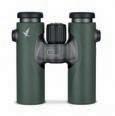

Make the most of every wildlife sighting with the Swarovski Optik CL Companion 8x30 binoculars. These elegant binoculars are perfect for seasoned birders and novice nature lovers. They offer lightweight, rugged durability and amazing performance, and fit perfectly in your hand. Enjoy unique wildlife experiences wherever you go. swarovskioptik.com
Nene, WWT Slimbridge
By Jessica Turchik (2021 shortlisted image)








What’s it like to look after the birds and other wildlife in our centres? Let’s find out! Join us as we catch up with John Arbon, Living Collections Manager at WWT London Wetland Centre, on a typical summer’s day in his ever-busy job.


I’m starting my day in the office, checking the computer to see if there are any messages from anyone or if there’s anything left over to do from yesterday. Then I put on my gear – normally waders (long wellies) or chest waders if I’m going to be working in deeper water.
We have a lot of hungry mouths to feed, so we need to prepare their food. Our otters have a different dish every day of the week! We give them mice, fish, prawns,



crabs, shellfish such as mussels and cockles, and chicken. We try to sneak a few vegetables in too – chopped carrots or grated courgettes – but they’re not very keen.
Most of our ducks, swans and geese eat wheat or fish pellets – they’re packed with protein and vitamins. Some of them eat a lot! Eiders are big sea ducks that need a whole bucketful to themselves. My wheelbarrow is full of buckets!







We always feed the otters first, because they are so energetic, they’re always hungry. Our pair of Asian short-clawed otters need four feeds a day! I sometimes put their food in a cage, so they have to dive under the water to reach it. While I’m feeding them, I’m watching closely to make sure they’re healthy. Otters do play-fight and can get injured.


Our birds live in natural pens that simulate where they live in the wild, such as reedbeds. I start in the tundra pen with the geese, while my colleague Magdalena goes to the wood and pine forest pens. All the while, I’m counting to make sure the birds are all there. And I’m looking to see if any are not feeding, if they are sitting on their own, or have ruffled feathers. If something is not right, we need to be on top of it.








Once everyone has had their breakfast, it’s time to clean off the bird poo from the paths, tables and bridges. We wash it down with a bucket of water and brush it off.
The otters get their second meal with an audience. It’s our first public feed of the day, and I tell our visitors all about the otters and how they live. We train the otters to take food off us, but they don’t always do what they’re told. Sometimes they stay fast asleep in one of their dens (called holts) instead of coming out.
My worst, most disgusting, stinkiest job is picking up otter poo. Otters often poo in piles in the same place, and they’re called otter latrines. Sometimes [GROSS OUT ALERT!] we might collect a sample to send off to the vet to check the otters are healthy. You can read a lot in an animal’s poo.
Back to the centre to fill in the day book – a diary that records everything we’ve found in the morning. That is important if we find a sick or injured bird because it reminds us exactly when it happened.
Could you do John’s job when you’re grown up? We asked him for the top three things you need to be a keeper.
• You must be an outgoing person. You could be talking to people all day long.
• Be enthusiastic about learning and sharing your knowledge. You need to know a huge amount about every species.
• You must want to look after wildlife. You’ll spend a lot of time caring for different creatures, so you have to like them, and be prepared to do the dirty jobs!






Wellies, waders, chest waders, nets to catch birds (just in case they are needed), wheelbarrow, buckets, food scoops, feed bowls.


In between feeds, there are just so many tasks to do. I might be mowing the grass, making a new fence, mending a broken gate, or cleaning inside one of the otter holts.



The afternoon public feeds of both otters and birds. Visitors follow us from pen to pen.
I focus on the people watching, answer their questions and tell them what I’m doing and about the wildlife.
Join the fun at our centres this summer and become a Junior Wetland Ranger. Learn what it takes to care for our wetlands and help us with our daily mission to save wetland nature. Set off to explore our reserves and take part in activities to discover what makes wetlands amazing. Shh, some behind-thescenes secrets may be revealed! Plan your visit – wwt.org.uk/ wetland-rangers


Last duties of the day include preparing food for the morning. We may stop work now, but the animals will still need their meals first thing tomorrow.





Summer wildflowers are a spectacle to see across the wet grasslands. A riot of colours includes white ox-eye daises, purple loosestrife, yellow fleabane and red campion. Start your own mini-meadow at home by making a seed bomb at the Wetland Secrets plant house on 10 September (£3 per person).
Nesting oystercatchers, lapwings and blackheaded gulls will all be raising young in June and July. We may even have some Mediterranean gulls nesting here this year. Fledgling warblers will be out and about in the reedbeds. Look for young bullfinches in the brambles and woodpecker families at the feeders.


Summer is the time to spot up to 12 species of butterfly, including gatekeepers, ringlets, large skippers, commas, painted ladies, peacocks and common blues. Dragonflies are plentiful in the reedbeds, with brown, migrant and southern hawkers and common darter being the more obvious ones. Turn to page 24 for a handy ID guide.
The wardens will be checking the barn owl boxes in June to see if there are any chicks this year. Sand martins will be rearing youngsters around the Sand Martin Hide, and may even have second broods. They will start migrating south in late August to early September, so don’t miss them.



Pond dipping
Grabanettofindpondlife atafamilydippingsession withourLearningTeam. Uptosixpeoplepergroup candiponweekendsand holidays.Suggesteddonation of£3perfamily.
Bat walks Spendaneveningsearching fornocturnalnature.
FamilieswillenjoyBatty aboutBatswhileadultscan searchforbatswithour wardens.Bookonline; variousdatesandtimes.
Begin wood carving workshops BentleyWildlifeCarvers teachyouhowtocreatea birdfromaroughed-out shape.Workshopsarerun 3September,1October and5November.Tickets onsalesoon.
Moth mornings
Join the fun this summer and become a Junior Wetland Ranger from 22 July to 31 August. Learn what it takes to care for our beautiful wetlands and help us with our daily mission to save wetland nature by taking part in fun activities like dressing up in ranger gear, health checking a swan and finding the leg rings on geese. Shh, some behind-the-scenes secrets may be revealed!


Explore the Coastal Creek Aviary to get nose to beak with sea ducks and wading birds, which come up onto the pathways to say hello! Spectacled eiders and longtailed ducks make a splash for their lunch each day at noon
Joinourwardenstoseewhat specieswerefoundinthe mothtrapsduringour overnightsurvey.Bringyour camera!£12ppplusregular centreadmission.
Bats and barn owls
Night-timenaturefor families!Dissectowlpellets andwalkthereserve watchingforbatsandowls, finishingoffwithacupof hotchocolate!£10pp.
at the Diving Duck fish feed with our keepers.
Pop by Pelican Cove at 2pm each day to join keepers for a chat about our four Dalmatian pelicans – Rogue, Valkyrie, Storm and Nebula. These big birds are the largest type of pelican in the world and eat several times a day, so you may get to see them scoop up a fish or two!
Discover night-time nature at dusk on our new Bat and Barn owl evening on 24 September. Dissect an owl pellet with our Learning Team then walk around the reserve as darkness falls. Arundel




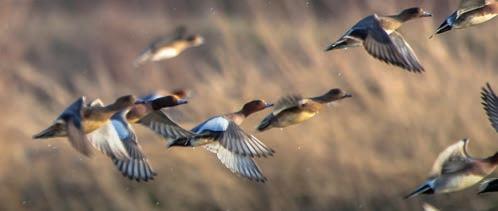

Join the fun this summer and become a Junior Wetland Ranger. Learn what it takes to care for our beautiful wetlands and help us with our daily mission to save wetland nature by taking part in fun activities like pond dipping, searching for minibeasts and guided sessions from our team with a take-home challenge to become a wetland hero.
There is so much fabulous wildlife to enjoy at Caerlaverock this summer! At high tide, our Saltcot Merse Observatory is a great place to see waders, including lapwings, black-tailed godwits and redshanks on the expanse of saltmarshes, as well as birds of prey hunting over the loaming.
We are lucky to be home to the UK’s most northerly population of natterjack toads. Listen out for the males’ rasping calls, luring females to their pond. They can be heard from up to a mile away!
The hedgerows and trees that shade our avenues are aflutter with small birds such as warblers, while bank voles scurry through tunnels in the long grass. Nest boxes and bird feeders on the Sir Peter Scott trail are being used by breeding tree sparrows and blue tits
Our Walk on the Wildside meadow follows the muddy banks of Lochar River, where you might find the tracks of otters and roe deer, along with orange-tip butterflies visiting the delicate pale blooms of cuckooflower. Dragonflies emerge from the paddock ponds and warm their wings in patches of sunlight before darting off to feast on insects.
When the season turns autumnal, we eagerly await the return of our vast flocks of barnacle geese and whooper swans, which migrate back to us from their breeding grounds in the Arctic.
Take your time experiencing all that our wetland has to offer, from panoramic views at the top of our towers to the adorable young of all the different waterbirds.
Enjoy the swallows’ aerial acrobatics, and look up on the Saltcot Merse to spot the songster serenading you from high above. You may not always see the skylark, but you can hear its song tumbling from the sky!
Caerlaverock
Dumfriesshire DG1 4RS 01387 770200
info.caerlaverock@wwt.org.uk
WWT Caerlaverock wwt.org.uk/caerlaverock
Have fun finding minibeasts and butterflies in our wildflower garden, then dip for pond creatures and watch dragonflies emerge from the water and take to the wing.
Keep your eyes down to spot the footprints of roe deer, brown hares, badgers and otters along our tree- and hedgerow-lined avenues and on our marvellous meadow trail

Walk on the wildside
Opendailyfrom1May until31August,explore moreofourreserve alongourmeadow, followingtheLochar River.Lookoutfor otteranddeertracks onthebanks,andspot butterfliesamongthe wildflowers.Swallows swoopforinsectsand dragonfliesdartto andfro.
Pond dipping
Aquatic habitats are fascinating. Take a net, tray and ID guide and dip in our paddock ponds for species such as smooth newts, water scorpions, great diving beetles and more.
Art exhibitions
We have a variety of exhibitors in our café gallery, with photography, textiles, paintings and
 Ian Henderson/WWT
Ian Henderson/WWT
Our ponds are full of amazing little creatures just waiting to be discovered by you and your family Sam
ceramics inspired by the natural world.
Swan feeds

When the whooper swans are back in autumn, there will be daily commentated feeds from the Sir Peter Scott Observatory at 2pm. Learn about these birds and see if you can identify individuals with leg rings.
Wild Goose Festival
Marking the return of the barnacle (left), pink-footed and other geese wintering on the Solway. There will be a variety of events taking place between 21 and 30 October.

“The experience takes your breath away. Every pond is full of different birds and the hides offer views of all sorts of birdlife. A relaxing and informative afternoon”
Brian C

A magical mix of wide estuary views, tidal lagoon, eelgrass mats, woodland walks, saltmarshes and reedbeds offer the perfect habitat for new life to thrive. From the emergence of bats, butterflies and dragonflies to the arrival of ducklings and goslings, a world of wildlife is waiting to be uncovered.
Summer is an exciting time to visit Castle Espie. From the emergence of bats, butterflies and dragonflies to the arrival of ducklings and goslings and our beautiful wildflower meadow in full bloom, a world of wildlife is waiting to be discovered.
The beautiful wildflower meadow will be in full bloom and alive with activity in the summer months. Swallows will return from Africa to the roundhouse after a long 6,000-mile journey. Brent geese will begin to arrive from Canada in early October.
Whether you are looking for family fun or are passionate about nature, there is something for everyone, whatever the weather, this summer at Castle Espie.
Whether you’re looking for family fun or are passionate about nature, there is something for everyone to enjoy, whatever the weather.
Join the fun on Saturdays and become a Junior Wetland Ranger. Explore our wild reserve and take part in fun activities to discover what makes wetlands amazing.

Gallery
Majuryfamilywillbe exhibitingfrom25June to17July;KilmoodArt Collective–23Julyto14 August;andCastleEspie CollectionKeeperKatie SpencerandCol–20 Augustto11September.
Junior Wetland Rangers
Jointhefunthis summerandbecomea JuniorWetlandRanger. EverySaturday throughouttheholidays, learnwhatittakesto careforourbeautiful wetlandsandhelpus withourdailymission tosavewetlandnature bytakingpartinfun activitieslikeplanting seedsandlearninghow tolookafterour
Enjoy a spectacular bird’s-eye view of the reserve from the discovery hides, and see who can spot the most wildlife.


collectionbirds.Shh, somebehind-the-scenes secretsmayberevealed!
Birdwatch Morning
Joinourreserveteamon thelastWednesdayof everymonthat10.30am astheytakeacloserlook atbirdsonourwetland reservewhiletheyareat theirmostactive.
Wildwood play
Ourwildwoodplayis openthroughoutthe year,asisoursoftplay area.Thereissomething forchildrenofallages!
Minibeast hunt
On6August,joinRoss McIlwrathashetakesa closerlookatminibeasts foundonthereserve.
Then follow the signs past the wishing tree and venture into the trees on a woodland adventure, where our treehouse, zip wire and dazzling green swamp await you.
Once you’ve built up an appetite, enjoy a picnic at one of the many outdoor benches or treat yourself to lunch from the Kingfisher Kitchen






































It’s summer and the good weather we all love is also enjoyed by dazzling dragonflies and bejewelled damselflies, which make good use of their limited time on the wing hunting small insects and soaking up the sun. Look out for them hawking along the paths and dodging visitors at high speeds.
They’re in good company, with some of the UK’s brightest butterflies on the wing through summer and well into autumn. Painted lady, red admiral, peacock, speckled wood and small tortoiseshell are all some of our biggest and most beautiful insect residents – sunny days are always your best chance to spot them flitting between flowers or resting on leaves. Pick up some helpful free spotter sheets at admissions to help you ID what you see, or download them from our website.
As we head later into the year, make your way to the hides. You never know what will be making use of our precious wetland habitats on any given day. Godwits, dunlins, greenshanks and redshanks are all regulars, but with the huge improvements we’ve made to the Freshwater Lagoon, we’re excited to see who turns up!
As the days get warmer, look out for shy reptiles – from slow-worms to grass snakes and brightly coloured male common lizards – basking in the sun. You’ll need to be quiet and light on your feet though – these creatures will quickly hide if they hear you coming!
During the summer holidays, join us for the UK’s

Snipe are often visible from the Peter Scott Hide

Canoe Safari
Paddlearoundour wetlandsthissummer from16Julyto4 September!£9.95per boat.Termsand conditionsapplyto keepeveryonesafe.See ourwebsiteforfullinfo.

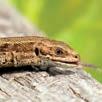
only LEGO® Brick Wetland Safari – it’s now bigger and better than ever! Meet 15 giant LEGO brick animals on our fun, interactive trail and find out how you can help build a better world for our
Duringschoolholidays, joinusforpond dipping,minibeast hunts,flamingotalks andmothmornings! Checkattheinfodesk toseewhat’son.
Den building
Beanawesomewild architectandtakea
“A brilliant place to visit!”
Mark
wanderdowntoWiggly Woodtoseeifyoucan buildyourveryown denusingthenatural materialsyoufindthere. Yourden,yourrules!
High Tide Watch
Getfront-rowseats foroneofthehighest tidesoftheautumn on10September. Startsat6pm;£10pp.
wetlands, with conservation facts and tips to make easy lifestyle changes for nature.
Say hello to favourite characters, including Lottie the Otter, Fred the Frog and Katie the Kingfisher, and meet new friends Percy the Pelican



Advancedbooking essential,notincluded withadmission.
Walk with a warden
Joinanexpertguidefor afully-accessibleand seasonallythemedwalk throughthereserve onthethirdSaturday ofeverymonth.Starts at11.30amatthe infodesk.
and Camille the Curlew, both on show here for the first time!
Extra energy to burn off?
Run to the super-wild Explore play area and complete the challenges in the fastest time you can. It’s great fun in any weather, the muddier the better we say!
Then check out Swan’s Nest Maze – race to the middle of the maze to find the big swan’s egg and then try to find your way back out. Don’t forget Water Vole City, too.
Summer is the time of year that insect life is at its most abundant. It is a great time to get to know moths, dragonflies, beetles, crickets and grasshoppers and all our other amazing minibeasts!
We have recorded 17 species of dragonflies and damselflies on-site, including Britain’s largest – the emperor dragonfly. Look out for butterflies such as common blues, meadow browns and gatekeepers, as well as day-flying moths such as burnet companion in June, six-spot burnets in July and the majestic Jersey tiger in August.
By early summer, chattering reed warblers fill the reedbeds, while our woodlands resound with the song of Cetti’s warblers Sand martins will be feeding their hungry fledglings in the artificial sand bank before the young make their first maiden flights in mid-June.





Listen out for water voles (Britain’s most endangered mammal) munching on reeds, and marsh frogs calling to attract a mate. Late summer evenings provide an opportunity to encounter a diverse array of bats that feed over the centre. Lots of bats forage over the reserve. The most numerous species and the smallest is the soprano pipistrelle The noctule is our largest bat and two of Britain’s rarest bats – Leisler’s and Nathusius’ pipistrelle – are also frequently detected hunting insects over wetlands.
Summer is our richest season. There is so much to seek, watch and explore. Families can take part in a variety of wild, watery adventures during the holidays, and experience our nature reserve after dark!
Do you think you have what it takes to care for our wetlands and super wildlife, and help us with our daily mission to save wetland nature?
Why not join us and become a Junior Wetland Ranger this summer and put your skills to the test?
As a Junior Wetland Ranger we’ll test your animal knowledge, mess cleaning and more, to see if you’re up to the task! Join Top Trainer Sam Feather and Rookie Ranger Charlie Beak in this fun, interactive family session, taking

place throughout the summer holiday.
When night falls, our centre becomes a truly magical place. Our Night Safaris will take you on an exciting adventure, exploring the centre, pond dipping at twilight, listening to wildlife and looking for bats and other nocturnal animals. And we’ll finish the evening with stories around a roaring campfire toasting marshmallows.
Don’t let your kids have all the fun – many of these activities are fun for the whole family to share. So join in!


Junior Wetland Ranger
Become a Junior Wetland Ranger this summer holiday from 23 July to 2 September.
Join Top Trainer Sam Feather

and Rookie Ranger Charlie Beak in our NEW fun and interactive family session. Find out what it takes to keep our wildlife happy and healthy. Learn how to care for our beautiful wetlands and help us with our daily mission to save wetland nature. There
are lots of other activities too. Suitable for children aged 5-11. Find out more online.
Night Safaris
Experience the reserve after dark on 5, 12, 19 and 26 August, with pond dipping at twilight, listening to wildlife and looking for bats and other nocturnal
animals. Finish the evening with stories around a roaring campfire toasting marshmallows. Suitable for adults and children over 8 years. Children must be accompanied by an adult.
Bat Walks
On 21 July, and 4 and 18 August, explore the centre
looking for bats, hedgehogs and other nocturnal wildlife.
Wildlife Photography Workshops
Unlock your talent behind the camera with professional photographer Jackie Rado, at workshops on 22 July, 31 August and 30 September.

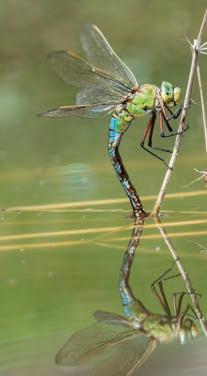
“Given the green space and vast array of wildlife, it’s hard to believe how central this location is. As birdwatchers, we came away feeling a sense of success from the day, with many species spotted. The site is well maintained, informative and fun”Tim J


Our enchanted light trail returns on 18 November until 8 January 2023, with new lights experiences to make winter even more special! Please note, we will not be hosting the Father Christmas experience this year.

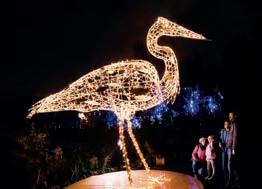

Summer is an amazing time for your family to get outdoors and be surrounded in nature. Become a Junior Wetland Ranger and take part in fun activities to discover what makes wetlands amazing. Shh, some behind-the-scenes secrets may be revealed!
The warm weather means the waterfowl gardens are a hive of activity, with butterflies and minibeasts among the flowers.
Get really close to dazzling dragonflies on a canoe safari, where you can gently float by nature – you may even see signs of water voles!



All sorts of ducklings are growing up, and our ponds are full of weird and wonderful water life you can discover through microscopes
Will you be brave enough to cross the stepping stones or ride the zip wire in the adventure playground? Finish up with a drink, some cake or an ice cream in our café.
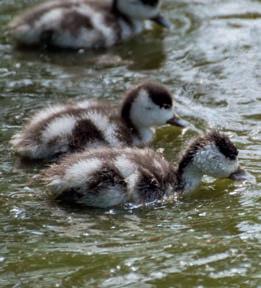
Summer is a feast for the senses at Martin Mere, with wildflowers in bloom around the reserve, and the air full of colourful dragonflies and butterflies to see and – if you’re quick! – take photographs of.
Look out from some of the hides and you may be surprised to see our herd of longhorn cattle grazing close by with their new calves. These ‘lawnmowers’ help keep the wetlands in tip-top condition for our migratory birds, and their grazing habits ensure the land supports an abundance of avocets, lapwings, gulls, terns, oystercatchers, redshanks, snipes and reed buntings, to name just a few of the species that benefit.
Keep a look out for our resident kingfishers and young barn owls as they fledge from the nest boxes. At the end of the summer, the water levels will begin rising. Regular visitors will spot the familiar sight of haymaking on the fields as we prepare for the arrival of 20,000 pink-footed geese in late September.
We will once again be offering late evenings in October so you can experience the spectacle of thousands and thousands of geese coming in to roost on the mere.

The arrival of autumn is heralded by the sight and sound of 20,000 pink-footed geese flying overhead
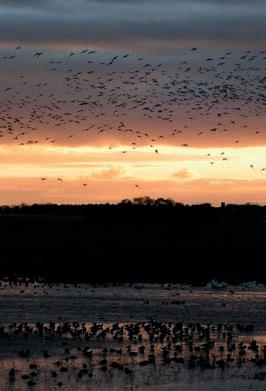


Join the fun this summer and become a Junior Wetland Ranger. Learn what it takes to care for our beautiful wetlands and help us with our daily mission to save wetland nature by taking part in fun activities like a flamingo catch, bird ringing and pond surveys. Come along to our ceremony each day at 4pm to collect your wetland ranger badge!
Animal Magic
It’s back! Animal Magic returns to Martin Mere on 24 and 25 September, when you can meet breathtaking bugs, marvellous meerkats, beautiful birds of prey and tremendous tortoises. The event is included as part of the admission price.
Pastel Workshop with artist Kerry Newell
Kerry’s workshops cater for all artistic abilities, even if you feel you have none. Beginner or more advanced, you’ll be pleasantly surprised at just how much can be achieved in one day. Join her on 25 June. £80pp; book online.
Dawn Flights

On 1, 8, 22 and 29 October, witness thousands of pink-footed geese wakening and leaving the roost in this early morning event, which starts at 7am. Warm up afterwards with a full English breakfast and a hot cup of tea in the Mere Side Café. £18pp; book online.
Wildlife Photography Workshops with Heather Beckett
Toddler Wednesdays
Every Wednesday in term time, come along for story time, singalong and toddler activities. The session starts at 10.30am and it is free to join in.
Bat and barn owl evenings
On 15, 16, 29 and 30 July, and 12 and 13 August, Martin Mere hosts special evenings with our resident bat expert. Firstly, go out onto the reserve to see if you can spot the barn owls hunting, before learning all about bats in an informative talk, and then go out and explore using bat detectors. £14pp; book online.
Heather Beckett offers this beginner-friendly photography workshop on 17 July and 9 October. Learn all about the technical side to cameras before going off and taking pictures at the centre. £75pp; book online.
Late geese evenings
From 1 October, the centre will open until 7pm every Saturday and Wednesday throughout October to allow you to witness the spectacle of thousands of pink-footed geese whiffling down on the mere to roost.
Date for your diary
North West Bird Watching Festival 2022 – 15 and 16 October.
pleasecheck our website for the latestupdatesat wwt.org.uk/slimbridge
Slimbridge
Gloucestershire GL2 7BT 01453 891900
Pre-book events online at wwt.org.uk/slimbridge events.slimbridge@wwt.org.uk
WWT Slimbridge wwt.org.uk/slimbridge
Summer is a spectacular season at Slimbridge. Explore the reserve on a Wild Safari, looking for colourful orchids from southern marsh to common twayblade, and wetland wildflowers including milkwort and the rare grass poly, which can be found in full bloom on Rushy Lake.
During July, kingfishers may be on their second broods, and from August onwards migrating birds start to arrive, including ruffs in their breeding plumage, green sandpipers and curlew sandpipers. The best areas to see them are the Rushy and the Tack Piece.
Search for butterflies including meadow browns, gatekeepers and common blues, and in late summer watch warblers from the Estuary Tower, including blackcaps and common and
lesser whitethroats. Dragonflies will also be busy on the wing – look for emperors, migrant hawkers and ruddy darters.
As autumn arrives, teals are the first ducks to arrive on-site in their plain and secretive ‘eclipse’ plumage as they moult their feathers. Migrating waders, ospreys, marsh harriers and the odd rarity will pass through, and if it’s been a successful breeding season, the common crane chicks will fledge.
From October, redwings and fieldfares arrive, along with white-fronted geese
Look for snipes from the Martin Smith Hide and golden plovers from the Estuary Tower. Towards the end of autumn the Bewick’s swans arrive after their epic journey from Arctic Russia. Get



“Great place to visit. The canoeing was really good fun. The pelicans are not to be missed. But my favourite was feeding the birds –felt like a big kid again” C4606EYlynnc

This summer, meet wonderful wetland wildlife at our amazing 360-seat open-air Living Wetland Theatre. Watch birds flying overhead and discover how each species is uniquely adapted to its
wetlands home. Meet species up close, from a crowned crane to a pink-backed pelican Immerse yourself in the sights and sounds of a British wetland in the Waterscapes Aviary,

Come and meet our pink-backed pelican, Sprout
family-friendly app, Wetland Heroes, will help you explore lesser-known areas, and discover fascinating facts and Slimbridge secrets along the way!
See if you can spot all six species of flamingo, marvellous mammals, including a friendly otter, and watery wonders in Toad Hall
and have close encounters with little egrets, smews and garganeys.
Throughout the school holidays, there’ll be a host of family activities, from the Wetlands Interactive Sandbox to pond dipping
A trip to Slimbridge is different from one season to the next and our free
Heat up in the Hawaiian landscape of Mission Possible, where you can meet the world’s rarest goose, the nene, and learn how WWT founder Sir Peter Scott helped save the species. Welly Boot Land, Riverlife outdoor play areas and indoor soft play are a must for little ones, while those looking for an extra adventure can paddle out on a Canoe Safari. Discover what Slimbridge means to you this season – search #MySlimbridge
Indulge all your senses this summer with our stunning wildflower displays

Evening on the Estuary
Watch the birds come into roost and the sun setting over the Severn Estuary on 13, 14 and 15 July.
Wildlife Photography for Beginners
Learn how to take the perfect wildlife picture and begin to understand some of the basics of photography composition and techniques on 14 October.

Autumn Wildlife Photography
Explore your artistic side with the amazing palette of autumn colours in the wetlands – both forest and flora. And discover the fantastic light, fungi, fruits and feathers on 21 October.
Scott House Museum Tours
Step back in time on a tour of Sir Peter Scott’s home. Find out how he made WWT Slimbridge the birthplace of modern conservation.
A visit to our wild reserve has much to offer in summer. Absorb the action down on Wader Lake from one of four hides, with fledglings taking to both water and sky. Marvel at common terns exploring the exposed mud and learning to fish alongside broods of regionally rare avocets, watched over by late-hatching grey herons from the hedge above.


Enjoy a mindful meander alongside wildflower meadows blooming with yellow rattle, northern marsh and bee orchids, or relax on a bench overlooking our dragonfly and amphibian ponds, teeming with colour and life in the summer sun. Highlights include common frogs, smooth newts, southern hawkers and even the occasional black-tailed skimmer.
The feeding stations at Hawthorn Wood and The Lookout become busy with young woodland birds as the season unfolds. Look out for young great spotted woodpeckers, blue tits and robins.
As summer ends, autumn brings change in the form of annual migration. Skeins of noisy geese pass overhead, species such as whimbrel stop to refuel en route elsewhere, and early winter visitors, including blacktailed godwits, greenshanks and the odd knots or dunlins, arrive. What will you spot first this year?
Summer is a glorious time of year in our wetlands. Good weather and abundant wildlife make for a brilliant day out for all ages and interests.
Become a Junior Wetland Ranger and take part in fun activities to discover what makes wetlands amazing. Shh, some behind-the-scenes secrets may be revealed!


Junior Wetland Rangers
Join the fun this summer and become a Junior Wetland Ranger from 25 July to 4 September! Help us with our daily mission to save wetland nature by taking part in fun activities like animal tracking, pond dipping and mini-ranger role play. Free with admission. See online for details.
Bubble Bonanza!
Bubbleologist Jesse Ward presents watery wetland play on
Like your wildlife fluffy?
Then head to the duckery, where our hatchlings can be seen under heat lamps indoors or paddling in their pens.
Sit and soak up the drama of our displaying Chilean flamingos and tell us if you spot any eggs!
Asian short-clawed otters Mimi, Musa and Buster love swimming and playing in the sunshine. Don’t miss twicedaily talks with our experts.


21 August, with magical soap bubbles, giant wands and clever tricks. Outdoor drop-in sessions and bookable workshops (£3 per child). See online for details.
Moth mornings
Join us on 6 and 17 August and 3 September as we open our moth trap to see what winged wonders we can find, ID and release. Meet at 10.30am at the
Our insect garden provides nectar for a host of bees and butterflies in summer. Pause a moment and watch the comings and goings of the insect hotel, where creepy-crawlies


education barn. No need to book; free with admission.
Wild walks
Enjoy a walk around our wild reserve, alongside our experts, for seasonal wildlife highlights. Meet at admissions at 11am on 3 and 23 July or 14 and 27 August. No need to book; free with admission.
Bat nights
Discover the nocturnal world of bats with a night-time stroll around our wetlands. September and October; details coming soon. See online for updates.
set up home among recycled materials.
The Working Wetland Garden overflows with bright flowers and waterlife including damselflies and frogs. Children can get hands-on pumping water and spinning the rain wheel in the nearby Waterlab
As autumn arrives, our collection birds change their feathers with the leaves, and our magical woodlands offer seasonal walks aplenty.




In July and August, our ducks keep a low profile as they moult out of their worn breeding feathers, becoming flightless and vulnerable. But there are plenty of this year’s young birds busily feeding ahead of migration, and failed breeders from further north are making their way south – so you never know what might drop in.
Swallows and house martins will still be busily feeding their broods, and with a profusion of flowers and insects, the reserve is teeming with life.
During July, you’ll be able to once again enjoy the Lady Fen walk route. Check the pools and ditches for birds and dragonflies, while increasing numbers of cranes use the reserve, especially this area, from July to October.
The summer walk will be open, and we’ve extended the route to take in more scrub and grasslands. This is fantastic for insects and small perching birds, such as tansy beetle and Cetti’s warbler.
You can hear male corncrakes (left) ‘crexing’ until early August when they will migrate to Africa for the winter. We’re hoping to help boost numbers of these rare birds on the Ouse Washes by becoming a release site to give them a foothold from which to spread into other wet grasslands in the Fens.

Wildlife gets a little bit closer in summer, as many of the species to be spotted include thousands of insects that call our wetlands home.
Bug hunting and pond dipping are fantastic ways to discover creatures in the water, among the flowers and zipping through the air.

Jointhefunthissummer andbecomeaJunior WetlandRangerfrom 23Julyto5September. Learnwhatittakesto careforourbeautiful wetlandsandhelpus
withourdailymissionto savewetlandnatureby takingpartinactivities likeponddippingand bughuntingandcheck outthemothdiscoveries inthemothtrap onWednesdays.
Sketch to screenprinting workshops Beinspiredbythe wetlandwildlife togetcreative andlearnanew skillwithartist NicolaBramley.
If you enjoy the wildlife of Welney, why not enhance your experience by staying on the reserve at the Wigeon House? Details at wwt.org.uk/ wigeon-house
We have two ponddipping stations at Welney, and all the equipment you need is provided. These are ready and available to use self-guided between now and the end of October. Ideal for weekend days out, holiday fun or when the
On27and
28July,and17and 18Augustfrom10am12noonor2-4pm,spend timetakinginsomeof ourwetlandspeciesand turningthemintoaprint onacanvasbagtotake homeandkeep.
Bat and barn owl evenings
Joinusforeveningevents on2and30July,20,24 and28Augustand 17Septemberto experiencesomeof ournocturnalwildlife. Watchresidentbarn owlshuntingacrossthe wetlandsasduskfalls,
kids are back at school, for home-school education trips.
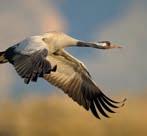

During the summer holidays, we’ll have lots of Junior Wetland Ranger activities on offer, including pond dipping, bug hunting, and extra-special events such as meeting moths

Meet our summer meadow munchers
usebatdetectorstolisten inonthefeedingofthese hungrymammalsand explorethemothstraps toseethevarietyofthese incredibleinsects.Check websitefortimes.
Conservation grazing walk
On10August,from 7-9.30pm,joinour GrazingOfficerfora walkaroundthereserve, toseehowandwhythe herdsofcattleareso importantforgrassland management.Learnhow thisworksalongsidethe needsofthewildlife.
Borrow our explorer backpacks during the holidays and on weekends for all the kit you need for a day of discovery.
By late summer, we’ll be welcoming back our cranes As numbers increase in the area, the flock becomes easier to see – and they can be vocal with their bugling calls. An amazing experience for young nature lovers.







































clock.

Dragonflies and damselflies are a Steart speciality, and summer is the time to see them out in force. Follow their meandering flights above the water surface. Look out for the bright stripes of the golden-ringed dragonfly. Visit when the weather is cool for a chance to see them at rest.
Wildflowers bloom all around the site, adding colour to the marshes and
Tide tables to help you plan your visit can be found on the ‘Visiting’ page of our website: wwt.org.uk/steart
Bespoke walks
Learnmoreabout Steartanditswildlife withyourownlocal guide.Contactusto arrangeabespoke tour.Donation:£20pp.
Pond dipping
Takealook belowthesurface. Drop-insessionsfor allagesavailablesome

“Miles of peaceful walks. You can walk for miles in this beautiful undiscovered part of Somerset. Take binoculars as there are hundreds of birds” Chris G
under foot for young frogs and toads. You may even be lucky enough to glimpse brown hare leverets hiding in the fields.
A vast array of birds drop in to feed. Summer visitors may include spoonbills, cattle egrets, black-winged stilts, ruffs, wheatears and yellow wagtails.
As autumn approaches, hips and berries appear on the hedgerows. Summer visitors depart and winter migrants begin to arrive. Rare passage birds pass through.
pathways. Keep your eyes open for butterflies and moths darting among the flowers.
The reserve is teeming with young life. Visit Otterhampton Marsh for sightings of juvenile avocets, lapwings, oystercatchers and little ringed plovers. Adults will vigorously defend their young from birds of prey, which can be a dramatic sight. Watch out

weekendsandschool holidays.Lookout fordetailsonour website,Twitterand Facebookpages.
Willow weaving
Getcreativewith willow.Drop-in sessionsforallages availablesome
You’ll find new willow longhorn cattle near the Quantock hides
weekendsandschool holidays.Lookout fordetailsonour website,Twitterand Facebookpages.


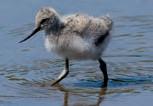
Self-led activities
Willow Sculpture
Trail –madeby localartistSophie Courtier.Leaflets availableon-site.
Wildlife Rubbings
Trail –bringacrayon andpickupaleaflet.
Geocache Trail –gettheappandfollow directionstofind hiddentreasures aroundthereserve.



















Waterlife chats to lifetime


We have been members of WWT for more than 15 years. We wanted to support the charity because it does good and important conservation work. Wetlands are vitally important in the battle against climate change as they capture carbon.
We go to WWT Martin Mere two or three times a year, and also visit Caerlaverock whenever possible. Martin Mere is a large and varied site, with good facilities and good birding to be had. We’ve visited other centres such as Welney and Slimbridge several times, and have been to Llanelli and Washington. We like to use the hides, observe the birds in the Living Collection and visit the café! We also enjoy the interesting exhibitions.
When we became patrons of WWT, we donated towards the cost of building the Sir Peter Scott Hide at Caerlaverock. Our names were engraved on a plaque. We met lots of WWT staff members and they were very kind to us. Later, we met the then CEO Martin Spray a few times. He even gave us a tour of Scott House at Slimbridge, which at the time he was using


John and Annie Harris Committed supporters and legacy pledgers
as his office. Through meeting the staff we developed much more of a personal connection with WWT.
As patrons, we make a yearly contribution and occasional gift to WWT. The money is used to benefit birds and other wetland wildlife, which is under constant threat from human activity. We also like that, through our donations, wetland habitats are protected and preserved. Newer WWT sites like Steart Marshes are of particular importance, and we hope to visit there soon.
We’ve decided to leave WWT a gift in our Will because we like the charity and what it does, and are lucky enough to have a little cash to spare. We enjoy supporting the charity in our lifetime but know that a gift in our Will also secures future wetland conservation – and that is so important.
We support WWT’s work to educate future generations about wildlife because they are the future and they will have to deal with the mess we are leaving them. They can’t do
that without sound information. Learning about the natural world and getting closer to its marvels enriches both mind and soul. It is sad to think that some of the creatures we enjoy today they will never get to see.
We hope WWT will teach young people that they are the joint guardians of a most wonderful natural world. They need to enjoy and marvel at it, and learn how to look after it. This is a matter of urgency, as time is running out.
We live at the edge of the Pennines, a lovely spot, and have been keen walkers for many years. We have always liked the outdoors, but our interest in wildlife began when we started birding. We started to visit nature reserves and, for the past 10 years, have helped to run a birding group. John is an artist, inspired by nature, and Annie is a keen gardener.
The latest gift we have made to WWT is for various improvement works at Caerlaverock. We know the reserve well, so we can easily imagine the good it will do! And when we visit in the future, we will glow with pride…












